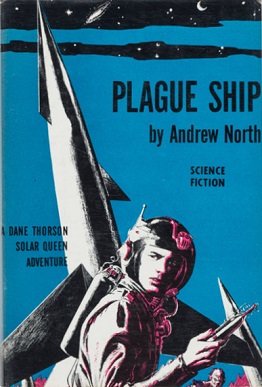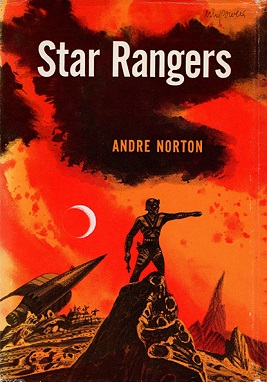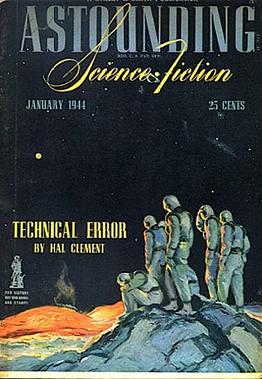
The Illustrated Man is a 1951 collection of 18 science fiction short stories by American writer Ray Bradbury. A recurring theme throughout the stories is the conflict of the cold mechanics of technology and the psychology of people. It was nominated for the International Fantasy Award in 1952.

Apocalyptic and post-apocalyptic fiction is a subgenre of science fiction in which the Earth's civilization is collapsing or has collapsed. The apocalypse event may be climatic, such as runaway climate change; astronomical, an impact event; destructive, nuclear holocaust or resource depletion; medical, a pandemic, whether natural or human-caused; end time, such as the Last Judgment, Second Coming or Ragnarök; or any other scenario in which the outcome is apocalyptic, such as a zombie apocalypse, AI takeover, technological singularity, dysgenics or alien invasion.

Destination: Void is a science fiction novel by American author Frank Herbert, the first of four novels in the Pandora Sequence series. It first appeared in Galaxy Magazine—illustrated by John Giunta—in August 1965, under the title "Do I Wake or Dream?", but was published in book form as Destination: Void the following year. A revised edition, edited and updated by the author, was released in 1978. The book stands alone but the story is continued - and embellished with more details of the Moonbase project and the history of the clones - in Herbert's other novels The Jesus Incident, The Lazarus Effect and The Ascension Factor, co-authored by Bill Ransom.
A bioship is a type of spacecraft or starship described in science fiction as either predominantly or totally composed of biological components, rather than being constructed from manufactured materials. Because of this, they nearly always have a distinctively organic look.

The Homecoming Saga is a science fiction series by Orson Scott Card. The series is patterned on the Book of Mormon. Some of the names also come from the Book of Mormon.

Houston, Houston, Do You Read? is a novella by James Tiptree Jr.. It won a Nebula Award for Best Novella and a Hugo Award for Best Novella in 1977.

The Alliance, formally known as the Union of Allied Planets, is a powerful fictional corporate supergovernment and law-enforcement organization in the Firefly franchise that controls the majority of territory within the known universe.

The Ark is the sixth serial of the third season of the British science fiction television series Doctor Who, which was first broadcast in four weekly parts from 5 to 26 March 1966.

Dumarest of Terra is a 33-volume series of science fiction novels by Edwin Charles Tubb. Each story is a self-contained adventure, but throughout the series, Earl Dumarest, the protagonist, searches for clues to the location of his home world, Earth.

Inconstant Moon is a science fiction short story collection by American author Larry Niven that was published in 1973. "Inconstant Moon" is also a 1971 short story that is included in the collection. The title refers to "O, swear not by the moon, th' inconstant moon", a quote from the balcony scene in William Shakespeare's Romeo and Juliet. The collection was assembled from the US collections The Shape of Space and All the Myriad Ways.

Starship Traveller is a single-player adventure gamebook written by Steve Jackson and illustrated by Peter Andrew Jones. Originally published by Puffin Books in 1983, the title is the fourth gamebook in the Fighting Fantasy series. It was later republished by Wizard Books in 2002. A digital version developed by Tin Man Games is available for Android, iOS, Windows 10, MacOS, and Linux.
"The Exiles" is a science fiction short story by Ray Bradbury. It was originally published as "The Mad Wizards of Mars" in Maclean's on September 15, 1949 and was reprinted, in revised form, the following year by The Magazine of Fantasy & Science Fiction. First collected in The Illustrated Man (1951), it was later included in the collections R Is for Rocket (1962), Bradbury Stories: 100 of His Most Celebrated Tales (2003), A Sound of Thunder and Other Stories (2005) and A Pleasure to Burn. It was also published in "The Eureka Years: Boucher and McComas's Magazine of Fantasy and Science Fiction" (ISBN 0553206737).

Fel Andar is a DC Comics character who also called himself Hawkman. There are two different versions of Fel Andar: the pre-Hawkworld version was created by Tony Isabella and Richard Howell, while the post-Hawkworld version was created by John Ostrander and Graham Nolan.
"Persistence of Vision" is the 24th episode of Star Trek: Voyager, the eighth episode in the second season. This science fiction television episode, part of the Star Trek franchise, is several hundred years in the future in Earth's galaxy. A Federation starship is stranded on the other side of the Galaxy, and its warp drive will take decades to return. In this episode, the ship's captain is revealed to be quite stressed and takes some to time to relax in the holodeck. But her experience, in a way typical of this franchise, explores illusion and reality aboard a spaceship encountering unknown aliens.
William Greenleaf is an American author. He was born in Illinois, spent most of his life in southern Arizona, and now lives in New Mexico near Santa Fe. He is a graduate of Arizona State University and worked as a corporate strategic and financial planner before changing careers to become a novelist, freelance book editor, and creative writing instructor.

Plague Ship is a science fiction novel by Andre Norton under the pseudonym Andrew North. It was published in 1956 by Gnome Press in an edition of 5,000 copies. The book is the second volume of the author's Solar Queen series.

Triplanetary is a science fiction novel and space opera by American writer E. E. Smith. It was first serialized in the magazine Amazing Stories in 1934. After the original four novels of the Lensman series were published, Smith expanded and reworked Triplanetary into the first of two prequels for the series. The fix-up novel Triplanetary was published in book form in 1948 by Fantasy Press. The second prequel, First Lensman, was a new original novel published in 1950 by Fantasy Press.

The Wizard of Linn is a science fiction novel by American writer A. E. van Vogt, a sequel to Empire of the Atom. The novel was originally serialized in the science fiction magazine Astounding Science Fiction. It was first published in book form in Germany in 1961 by Terra Sonderband, as Der Zauberer von Linn.

Star Rangers, also known as The Last Planet, is a science fiction novel by the American author Andre Norton. The novel was published on August 20, 1953, by Harcourt, Brace & Company. This is one of Norton's Central Control books, which lay out the history of a galactic empire through events suggested by Norton's understanding of Terran history.

Far Centaurus is a science fiction short story by Canadian-American writer A. E. van Vogt, first published in Astounding Science Fiction in 1944. Writer and critic P. Schuyler Miller called it "unforgettable and unforgotten."
















